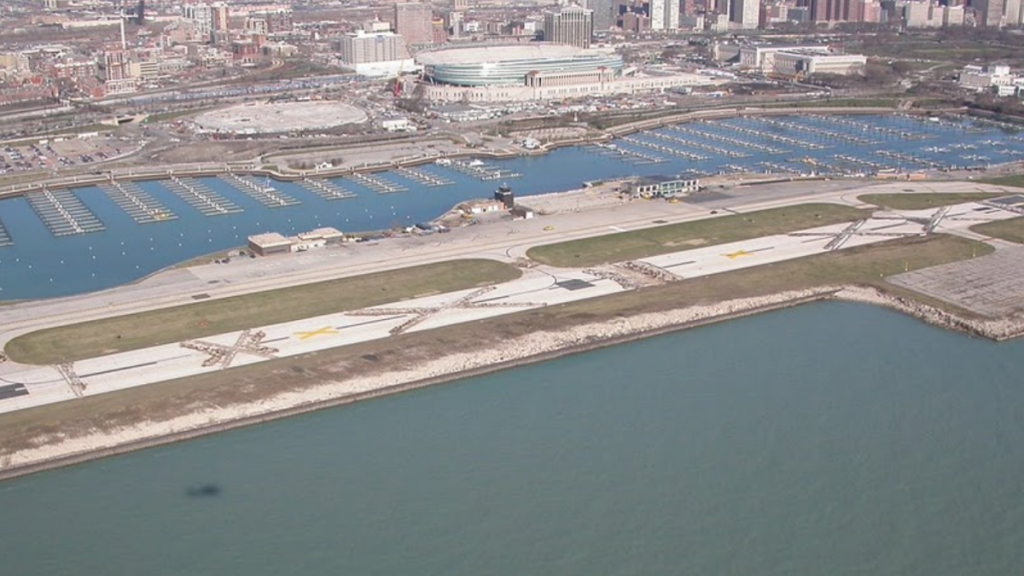Chicago's Former Mayor Once Destroyed An Airport Under The Cover Of Night

Meigs Field’s destroyed runway.Photo: Zargnut | Public Domain
Just over 19 years ago, former Chicago Mayor Richard M. Daley pulled an astonishing move that still shocks and disappoints aviation communities to this day. Under the cover of night, Mayor Daley took the law into his own hands and ordered the destruction of famed Meigs Field, impacting aviation for years to come.
If you’re not a plane nut but have ever played an older version of Microsoft Flight Simulator before, Merrill C. Meigs Field may ring a bell. As the default airport option in the flight simulator, virtual pilots got to depart over Lake Michigan with beautiful Chicago as a backdrop. Flying Magazine reminds us that for 55 years, pilots departing from the strip got to witness Chicago grow into the bustling city it is today.
The story of Meigs Field begins with the peninsula that it was constructed on. In 1909, urban planner and architect Daniel H. Burnham published the Plan of Chicago. The book recommended improvements to the city like wider streets, parks, civic buildings, harbors and more. It even called for a highway system that circled the then vastly growing city.
Burnham died in 1912 before any part of his ideas became reality. One of his ideas called for the creation of an island that would serve as a lakefront park. By 1916, the co-author of his book, Edward H. Bennett, suggested that the site would be ideal for aviation. In 1920, ground broke on construction and the island was finished in 1925. The proposed airport didn’t get built, but the peninsula soon found itself to be the home of the Adler Planetarium and a World’s Fair. Flying boats reached Chicago by way of the peninsula.
The airport finally opened in 1948, Flying notes. And it was named the Merrill C. Meigs Field in 1950 after the aviation enthusiast and publisher of the Chicago Herald and Examiner of the same name.
G/O Media may get a commission
Photo: USGS
For a time, Meigs was a busy place. While general aviation pilots learned to fly and parked their planes there, the airport was also home to a number of small regional airlines that carted people to destinations throughout Illinois and neighboring Midwestern states. From Meigs, you could catch a flight to the center of the state or ride aboard one of the many short-lived helicopter airlines. Meigs also found itself a hub for medical services delivering patients and organs to city hospitals.
But this wouldn’t last forever, and as Flying Magazine notes, the future of the airport came into question when in the 1980s Chicago Mayor Jane Byrne suggested converting the airport into a park:
Local pilots, aviation advocacy groups, and businesses that appreciated the convenience of an airport so close to downtown objected to the idea. The FAA noted that the airport had received FAA grants, and each grant carried an assurance that the airport would remain open a set amount of time—usually 25 years—so that the grants could be amortized. The airport had most recently accepted a grant in 1976.
Mayor Byrne accepted that the airport was there to stay, but Chicago’s 54th mayor, Richard M. Daley, did not.
In 1994, Mayor Daley announced plans to convert the airport into a park. One of his first moves to see this through was to have Chicago Park District not renew the airport’s lease. When the lease expired in 1996 workers painted large X marks on the runway, denoting a closed airport.
Mayor Daley received pushback on many fronts. Not only did the Federal Aviation Administration and Illinois state legislature fight the closure, but so did several groups representing pilots, medical transport services, youth programs, air traffic controllers, businesses and more. Within weeks, the groups had the airport reopened. But Mayor Daley wasn’t giving up that easily. He kept the pressure on to get the airport permanently closed.
Mayor Daley was dealt another blow in 2001 when he came to an agreement that, in exchange for allowing O’Hare International Airport to expand, Meigs would stay open until at least 2026, Aero News notes. Yet, Mayor Daley wasn’t going to that stop him from getting what he wanted.
Near midnight on March 30, 2003 Mayor Daley ordered the destruction of the airport. As reported by the Chicago Tribune, bulldozers escorted by the Chicago Police rolled out onto the tarmac and started tearing X-marks into the runway. And to make sure that nobody saw what was going on, a fire engine placed a spotlight into the view of the webcam at Adler Planetarium.
Stranded aircraft with the destroyed runway in the background.Photo: Scott Olson / Staff (Getty Images)
That’s outrageous enough, but Flying details how Mayor Daley tried to explain what he ordered:
The morning after the closure, Daley held a news conference, during which he claimed the runway was destroyed in the name of security, alleging that aircraft could be launched from Meigs Field and used as weapons to attack downtown Chicago, similar to the attack on the World Trade Center on September 11.
The story quickly fell apart when the Department of Homeland Security stated that the airport’s proximity to downtown Chicago was not viewed as a risk and that no threats had been made against the Windy City.
Daley later changed his story, stating to several media outlets that the abrupt closure was done to prevent lengthy and costly litigation as various entities fought to keep the airport open.
In short, Mayor Daley ordered the airport to be destroyed so he didn’t have to fight to have the airport closed through proper legal channels. And in doing so, he managed to not only spark a legal battle with the aviation groups that he fought with in 1996, but it made some feel that the actions were an abuse of mayoral power.
Ultimately, the FAA fined Chicago $33,000 for failing to give a 30-day notice before closing an airport. If you think that’s nothing for a city, you’re not wrong. The penalty for closing an airport without proper notice was $1,100 per day. The fine was later increased to $10,000 per day and Chicago ended up paying out $33,000 plus a repayment of $1 million for the FAA Airport Improvement Program funds that were used to destroy the airport.
Meigs today is sometimes remembered as an airstrip for the one percent, but it was more than that for much of its life. Pilots recall stories of learning to fly at the airport or being a passenger aboard one of the commercial flights that departed from the airport. While the field was indeed a home to the rich, you didn’t have to be a one-percenter to enjoy aviation from the field.
In the 1990s and until the airport’s closure, Chicago-area Tuskegee Airmen also provided free airplane rides and education to Chicago youth. And in 1992, a Boeing 727-100 trijet landed at Meigs’ 3,900 foot runway with space to spare.
That aircraft is now in Chicago’s Museum of Science and Industry.
While the field is gone, the land has been repurposed in a very positive way. Northerly Island is now home to a huge lakefront park where you can get in some good exercise alongside Lake Michigan. It’s a place that’s now truly accessible for everyone! And if you’re an aviation geek, parts of the field’s past remain in the form of the still-standing airport terminal building and air traffic control tower.






